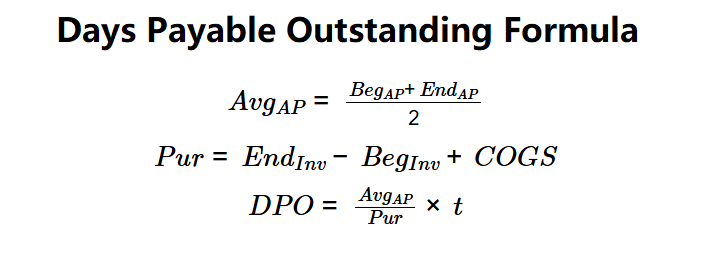1. What is the Days Payable Outstanding Calculator?
Definition: This calculator computes the days payable outstanding (\( DPO \)), which measures the average number of days a company takes to pay its suppliers, indicating payment efficiency.
Purpose: Helps businesses and analysts assess accounts payable management, optimize cash flow, and evaluate supplier payment terms.
2. How Does the Calculator Work?
The calculator uses a three-step process to compute DPO:
Formulas:
\( Avg_{AP} = \frac{Beg_{AP} + End_{AP}}{2} \)
\( Pur = End_{Inv} - Beg_{Inv} + COGS \)
\( DPO = \frac{Avg_{AP}}{Pur} \times t \)
Where:
- \( DPO \): Days Payable Outstanding (days)
- \( Avg_{AP} \): Average Accounts Payable (dollars)
- \( Beg_{AP} \): Beginning Accounts Payable (dollars)
- \( End_{AP} \): Ending Accounts Payable (dollars)
- \( Pur \): Purchases (dollars)
- \( Beg_{Inv} \): Beginning Inventory (dollars)
- \( End_{Inv} \): Ending Inventory (dollars)
- \( COGS \): Cost of Goods Sold (dollars)
- \( t \): Days in Accounting Period (days)
Steps:
- Step 1: Calculate \( Avg_{AP} \). Average the beginning and ending accounts payable.
- Step 2: Calculate \( Pur \). Compute purchases as ending inventory minus beginning inventory plus COGS.
- Step 3: Calculate \( DPO \). Divide \( Avg_{AP} \) by \( Pur \) and multiply by \( t \).
3. Importance of Days Payable Outstanding Calculation
Calculating DPO is crucial for:
- Cash Flow Management: A higher \( DPO \) indicates slower payments, preserving cash longer.
- Supplier Relations: Helps balance timely payments with cash flow optimization.
- Financial Health: Provides insight into payment practices and liquidity management.
4. Using the Calculator
Example 1 (Alan's Amazing Anglegrinders):
\( Beg_{AP} = \$150,000 \), \( End_{AP} = \$200,000 \), \( Beg_{Inv} = \$200,000 \), \( End_{Inv} = \$400,000 \), \( COGS = \$150,000 \), \( t = 365 \):
- Step 1: \( Avg_{AP} = \frac{150,000 + 200,000}{2} = \$175,000 \).
- Step 2: \( Pur = 400,000 - 200,000 + 150,000 = \$350,000 \).
- Step 3: \( DPO = \frac{175,000}{350,000} \times 365 = 182.50 \) days.
- Results: \( Avg_{AP} = \$175,000 \), \( Pur = \$350,000 \), \( DPO = 182.50 \) days.
A DPO of 182.50 days indicates slow supplier payments, preserving cash flow.
Example 2:
\( Beg_{AP} = \$100,000 \), \( End_{AP} = \$120,000 \), \( Beg_{Inv} = \$300,000 \), \( End_{Inv} = \$350,000 \), \( COGS = \$200,000 \), \( t = 365 \):
- Step 1: \( Avg_{AP} = \frac{100,000 + 120,000}{2} = \$110,000 \).
- Step 2: \( Pur = 350,000 - 300,000 + 200,000 = \$250,000 \).
- Step 3: \( DPO = \frac{110,000}{250,000} \times 365 \approx 160.60 \) days.
- Results: \( Avg_{AP} = \$110,000 \), \( Pur = \$250,000 \), \( DPO = 160.60 \) days.
A DPO of 160.60 days suggests moderate payment delays.
Example 3:
\( Beg_{AP} = \$50,000 \), \( End_{AP} = \$60,000 \), \( Beg_{Inv} = \$500,000 \), \( End_{Inv} = \$450,000 \), \( COGS = \$300,000 \), \( t = 365 \):
- Step 1: \( Avg_{AP} = \frac{50,000 + 60,000}{2} = \$55,000 \).
- Step 2: \( Pur = 450,000 - 500,000 + 300,000 = \$250,000 \).
- Step 3: \( DPO = \frac{55,000}{250,000} \times 365 \approx 80.30 \) days.
- Results: \( Avg_{AP} = \$55,000 \), \( Pur = \$250,000 \), \( DPO = 80.30 \) days.
A DPO of 80.30 days indicates faster supplier payments.
5. Frequently Asked Questions (FAQ)
Q: What is days payable outstanding?
A: Days payable outstanding (\( DPO \)) is the average number of days a company takes to pay its suppliers, reflecting payment efficiency.
Q: What is a good DPO value?
A: A higher \( DPO \) (e.g., 60-90 days) can benefit cash flow but varies by industry; too high may strain supplier relations.
Q: Can DPO be negative?
A: No, since \( Avg_{AP} \), \( Pur \), and \( t \) are typically non-negative, \( DPO \) is non-negative.
Days Payable Outstanding Calculator© - All Rights Reserved 2025
 Home
Home
 Back
Back
